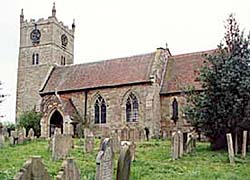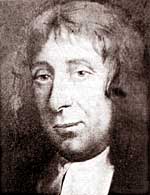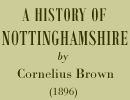< Previous | Contents | Next >
Eakring

Church of St Andrew, Eakring. The west tower dates from the 13th century, though the top stage is late medieval. The chancel was built in the early 14th century: the church was extensively restored by J P St Aubyn, 1880-1. (Photo: A Nicholson, 2002).
The next village to Bilsthorpe standing in this pleasant part of Nottinghamshire is Eakring, spelt in Doomsday Book ‘Echering.’ One of the early owners of Eakring was Gilbert de Gant, a grandson of the De Gant who accompanied the Conqueror in his invasion of this kingdom. It was Gilbert de Gant who, in 1148, founded Rufford Abbey, and endowed it with his property in this village. William de Albini, whose family subsequently became Earls of Arundel, was also the owner of land at Eakring, and became a benefactor of Rufford. In process of time the manor fell into the possession of Roger, Earl of Rutland, from whom it passed to the Earl of Kingston, the portion of the property vested in the monastery going with Rufford from the Earl of Shrewsbury to Lord Halifax.

William Mompesson, Rector of Eyam from 1664 to 1670 and of Eakring from 1671 to 1709.
Nothing of historic importance has transpired at Eakring, but in its church lies one who, though his name is not inscribed on battle scrolls, is none the less a hero. William Mompesson was Rector of the parish for twenty-eight years; but before this he had been Rector of Eyam, in Derbyshire, when the deadly plague swept through the land. Dr. Meads, in his ‘Treatise on the Plague,’ says it was brought to Eyam in September, 1665, in some material sent from London to a tailor in the parish. After seizing the tailor’s family, it spread to the other inhabitants, four-fifths of whom were swept away, and it was only through the exertions and timely precautions of the Rector that the epidemic was prevented from spreading to the surrounding neighbourhood. The clergyman never ceased to visit and care for his suffering flock, and in order to ensure that the contagion might not be spread through him, he preached to his hearers from a rock in the open air instead of in the church. As many as 266 persons fell victims, 78 of whom died in August, 1666, in which month Mr. Mompesson’s wife died, and there is a monument to her in Eyam churchyard. A pathetic letter was written by him to Sir George Savile, the patron of the living, in which he galls himself a dying man, and bespeaks the favour of the Baronet for his orphans. Happily, he survived the terrors of the plague and his severe bereavement, and was presented to the living of Eakring by his noble friend and patron. For some time the villagers of Eakring were fearful lest their new clergyman might be infected with the plague, and he resided in a hut in Rufford Park till that feeling wore away. Mr. Mompesson died in 1708, and in the chancel on the north side is a brass erected to his memory. In the words of William and Mary Howitt, who published a book in 1827 entitled ‘The Desolation of Eyam, and other Poems:’
‘Bright shines the sun upon the white wails wreathed
With flowers and branches, in that lone
And sheltered quiet where the mourner breathed His future anguish; pleasant then the tone
Of bees; the shadows o’er still waters thrown
From the broad plane-tree; in the gray church nigh
And near that altar where his faith was known, Humble as his own spirit we descry
The record which denotes where sacred ashes lie.’
